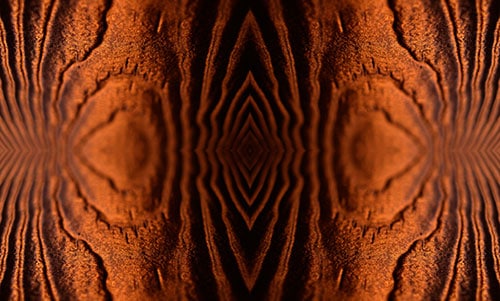Music and psychedelics dance in the same deep cosmos of consciousness. Taken individually, each has the potential to elicit experiences of emotional catharsis and spiritual transcendence, granting access to expanded self-awareness and ecstatic states beyond the bounds of Self and ego. When experienced in conjunction, a profound synergy often arises. Music bypasses the linear brain, providing a structure and energetic container that guides and amplifies the “mind-manifesting” power of a psychedelic trip. Carried along this current, the journeyer travels through inner landscapes populated by feelings and memories, insights and visions, symbols and archetypes—a psychospiritual voyage that can lead to deep healing and transformation.
For many practitioners of psychedelic-assisted therapy, music is embraced as a vital component of this work. Not unlike a plunge into a rushing river, bereft of a life vest or canoe, venturing into a psychedelic session without the support of music poses the risk of being helplessly tossed and submerged in turbulent psychic waters. The pioneering Western researchers and clinicians exploring psychedelic therapy in the 1950s and 60s recognized this and incorporated music as a key part of their protocols. Bill Richards and Stanislav Grof, two progenitors of LSD psychotherapy, developed and wrote about the useful role of music in psychedelic therapy to support patients non-verbally and facilitate peak experiences during their sessions. Other early psychedelic researchers (notably, Walter Pahnke and Helen Bonny) built on this work, further elucidating the benefits of music in psychedelic therapy.
While government prohibition in 1970 stopped academic exploration of psychedelics for many decades, the dance between music and these mystical medicines carried on. Raves, festivals, and underground therapy sessions kept the beat alive for many psychonauts enamored with the ecstatic states conjured by psychedelics paired with a musical experience. More recently, a new wave of psychedelic research, including studies by Roland Griffiths and Mendel Kaelen, has assembled further evidence for the pivotal role music plays in transformative psychedelic sessions.
As with much of the scientific work in the so-called “Psychedelic Renaissance” taking root around the world, these empirical findings are hardly novel discoveries. Indigenous peoples have long known about the power of music to aid in healing and deepen states of consciousness accessed through entheogenic substances. Over countless centuries, well before the advent of modern science, Amazonian curanderos developed the spiritual technology of singing icaros—sacred medicine songs that transmit healing energy—during ayahuasca ceremonies. Music, drumming, chanting, ecstatic movement, and ritual are central to nearly all traditional healing practices around the world. Many of these also involve the use of psychoactive plants and fungi currently being investigated by Western researchers for their therapeutic potential. While there is value in scientific validation of these practices to optimize outcomes and adapt culturally appropriate models of psychedelic healing for the Global North, we must acknowledge the wisdom of traditional cultures and reject the hubristic notion that we are creating the wheel from scratch.
So, what are we learning today about the role of music in psychedelic-assisted therapy? Kaelen’s and Griffith’s studies suggest that music can be a key factor in maximizing benefits for patients undergoing a psychedelic session. This appears to be especially true when the music facilitates a mystical experience—a state of consciousness characterized by a profound sense of oneness, interconnectedness, and ineffability. Several studies have found associations between the occurrence of a mystical experience during psychedelic therapy and improved clinical outcomes, such as relief from addiction and end-of-life distress. If, as the data suggests, carefully selected music can increase the odds of catalyzing this transformative state, researchers and practitioners would be wise to explore this.
Not all psychedelic playlists are created equal, however. As Kaelen’s work suggests, how an individual responds to the music guiding their journey is a crucial factor in the process. Surveying participants following psilocybin therapy sessions, his research team discovered that the more the music was “liked” or found to elicit a sense of “resonance” and “openness” during their journey, the better they fared therapeutically. Unsurprisingly, personal preference seems to play a prominent role here. While the sonorous strings of a Bach concerto might lift one listener to ecstatic heights, another might find their bliss in the warm, synthesized drones of a Stars of the Lid record. One helpful approach to maximize resonance may be through developing pre-treatment questionnaires featuring samples of music across a swath of genres to identify any affinities and aversions. This data could then be used to personalize the playlist selection accordingly.
More research is needed to develop best practices for designing musical accompaniment to a psychedelic session. Additionally, we may find that the unique phenomenological signatures of different medicines gel more with particular musical styles or characteristics. Anecdotally, it seems that more ethereal, ambient tracks may work well with LSD or psilocybin, while the same song is likely to stall the forward momentum of an MDMA or ketamine trip, leaving the listener uncomfortably “marooned.” Such track selection considerations are also important when crafting the energetic “arc” of a psychedelic playlist, with attention paid to the onset, peak, and descending segments—as well as the overall duration—of a typical medicine experience. Simply tossing random songs into a Spotify or iTunes folder and hitting shuffle is probably not the ideal approach.
As the field of psychedelic therapy evolves, the powerful and multifaceted role of music is sure to be explored in more depth. Playlists for psychedelic-assisted therapy sessions are plentiful on Spotify, curated by clinics and organizations such as the Psychedelic Research and Training Institute, Johns Hopkins, and Polaris Insight Center. Forward-thinking musicians like Jon Hopkins are beginning to lend their talents to crafting full album-length soundtracks for psychedelic sessions. In collaboration with Kaelen, Hopkins and legendary musician Brian Eno have developed an app called Wavepaths that creates algorithmically generated electronic soundscapes individually tailored to a psychedelic journeyer’s predilections. Such AI-controlled software can be connected to biofeedback devices to map a journeyer’s subjective experience and adjust the auditory environment in real time.
Innovative as these approaches may be, we may find that a computer-created musical experience is no match for the impassioned artistry of a human composer. Music, after all, is the language of emotions, and it is this evocative force, harnessed by gifted musicians, that propels us to wild imaginal realms when we fully submit to it—whether at the symphony or deep in ketamine space. Furthermore, the potential role of the therapist in guiding the session musically could be lost in a fully automated approach. Perhaps the future of music in psychedelic therapy may look like some combination of the two: individualized, technology-assisted playlist curation (e.g., through computerized questionnaires linked to musical databases) and the engaged participation of a therapist-as-DJ, subtly adjusting the mood and arc of the soundtrack as needed. The possibilities are as vast as the sonic tableaus of music itself.
These parallel paths for inner exploration and healing, music and psychedelics, are as old as humanity’s quest for meaning and knowledge. As the Psychedelic Renaissance continues to unfold, so shall our reconnection to these ancient practices refine and expand. For those of us who hold these tools and traditions as sacred, the push towards corporatization and medicalization in the psychedelic space should give us cause for concern. To protect both music and psychedelics from commodification and proprietary control, we might envision community-held models for psychedelic healing where local musicians collaborate with therapists, perhaps in group settings resembling indigenous ceremonial approaches. Keeping these gifts of our common heritage open source—and open-hearted—feels vital as we move forward.
The melodies of the Great Mystery beckon to us—listen deeply!
“Psychedelic: Manifestations of the Mind” by Jason A. Samfield is licensed under CC BY-NC-SA 2.0
For many practitioners of psychedelic-assisted therapy, music is embraced as a vital component of this work. Not unlike a plunge into a rushing river, bereft of a life vest or canoe, venturing into a psychedelic session without the support of music poses the risk of being helplessly tossed and submerged in turbulent psychic waters. The pioneering Western researchers and clinicians exploring psychedelic therapy in the 1950s and 60s recognized this and incorporated music as a key part of their protocols. Bill Richards and Stanislav Grof, two progenitors of LSD psychotherapy, developed and wrote about the useful role of music in psychedelic therapy to support patients non-verbally and facilitate peak experiences during their sessions. Other early psychedelic researchers (notably, Walter Pahnke and Helen Bonny) built on this work, further elucidating the benefits of music in psychedelic therapy.
While government prohibition in 1970 stopped academic exploration of psychedelics for many decades, the dance between music and these mystical medicines carried on. Raves, festivals, and underground therapy sessions kept the beat alive for many psychonauts enamored with the ecstatic states conjured by psychedelics paired with a musical experience. More recently, a new wave of psychedelic research, including studies by Roland Griffiths and Mendel Kaelen, has assembled further evidence for the pivotal role music plays in transformative psychedelic sessions.
As with much of the scientific work in the so-called “Psychedelic Renaissance” taking root around the world, these empirical findings are hardly novel discoveries. Indigenous peoples have long known about the power of music to aid in healing and deepen states of consciousness accessed through entheogenic substances. Over countless centuries, well before the advent of modern science, Amazonian curanderos developed the spiritual technology of singing icaros—sacred medicine songs that transmit healing energy—during ayahuasca ceremonies. Music, drumming, chanting, ecstatic movement, and ritual are central to nearly all traditional healing practices around the world. Many of these also involve the use of psychoactive plants and fungi currently being investigated by Western researchers for their therapeutic potential. While there is value in scientific validation of these practices to optimize outcomes and adapt culturally appropriate models of psychedelic healing for the Global North, we must acknowledge the wisdom of traditional cultures and reject the hubristic notion that we are creating the wheel from scratch.
So, what are we learning today about the role of music in psychedelic-assisted therapy? Kaelen’s and Griffith’s studies suggest that music can be a key factor in maximizing benefits for patients undergoing a psychedelic session. This appears to be especially true when the music facilitates a mystical experience—a state of consciousness characterized by a profound sense of oneness, interconnectedness, and ineffability. Several studies have found associations between the occurrence of a mystical experience during psychedelic therapy and improved clinical outcomes, such as relief from addiction and end-of-life distress. If, as the data suggests, carefully selected music can increase the odds of catalyzing this transformative state, researchers and practitioners would be wise to explore this.
Not all psychedelic playlists are created equal, however. As Kaelen’s work suggests, how an individual responds to the music guiding their journey is a crucial factor in the process. Surveying participants following psilocybin therapy sessions, his research team discovered that the more the music was “liked” or found to elicit a sense of “resonance” and “openness” during their journey, the better they fared therapeutically. Unsurprisingly, personal preference seems to play a prominent role here. While the sonorous strings of a Bach concerto might lift one listener to ecstatic heights, another might find their bliss in the warm, synthesized drones of a Stars of the Lid record. One helpful approach to maximize resonance may be through developing pre-treatment questionnaires featuring samples of music across a swath of genres to identify any affinities and aversions. This data could then be used to personalize the playlist selection accordingly.
More research is needed to develop best practices for designing musical accompaniment to a psychedelic session. Additionally, we may find that the unique phenomenological signatures of different medicines gel more with particular musical styles or characteristics. Anecdotally, it seems that more ethereal, ambient tracks may work well with LSD or psilocybin, while the same song is likely to stall the forward momentum of an MDMA or ketamine trip, leaving the listener uncomfortably “marooned.” Such track selection considerations are also important when crafting the energetic “arc” of a psychedelic playlist, with attention paid to the onset, peak, and descending segments—as well as the overall duration—of a typical medicine experience. Simply tossing random songs into a Spotify or iTunes folder and hitting shuffle is probably not the ideal approach.
As the field of psychedelic therapy evolves, the powerful and multifaceted role of music is sure to be explored in more depth. Playlists for psychedelic-assisted therapy sessions are plentiful on Spotify, curated by clinics and organizations such as the Psychedelic Research and Training Institute, Johns Hopkins, and Polaris Insight Center. Forward-thinking musicians like Jon Hopkins are beginning to lend their talents to crafting full album-length soundtracks for psychedelic sessions. In collaboration with Kaelen, Hopkins and legendary musician Brian Eno have developed an app called Wavepaths that creates algorithmically generated electronic soundscapes individually tailored to a psychedelic journeyer’s predilections. Such AI-controlled software can be connected to biofeedback devices to map a journeyer’s subjective experience and adjust the auditory environment in real time.
Innovative as these approaches may be, we may find that a computer-created musical experience is no match for the impassioned artistry of a human composer. Music, after all, is the language of emotions, and it is this evocative force, harnessed by gifted musicians, that propels us to wild imaginal realms when we fully submit to it—whether at the symphony or deep in ketamine space. Furthermore, the potential role of the therapist in guiding the session musically could be lost in a fully automated approach. Perhaps the future of music in psychedelic therapy may look like some combination of the two: individualized, technology-assisted playlist curation (e.g., through computerized questionnaires linked to musical databases) and the engaged participation of a therapist-as-DJ, subtly adjusting the mood and arc of the soundtrack as needed. The possibilities are as vast as the sonic tableaus of music itself.
These parallel paths for inner exploration and healing, music and psychedelics, are as old as humanity’s quest for meaning and knowledge. As the Psychedelic Renaissance continues to unfold, so shall our reconnection to these ancient practices refine and expand. For those of us who hold these tools and traditions as sacred, the push towards corporatization and medicalization in the psychedelic space should give us cause for concern. To protect both music and psychedelics from commodification and proprietary control, we might envision community-held models for psychedelic healing where local musicians collaborate with therapists, perhaps in group settings resembling indigenous ceremonial approaches. Keeping these gifts of our common heritage open source—and open-hearted—feels vital as we move forward.
The melodies of the Great Mystery beckon to us—listen deeply!
“Psychedelic: Manifestations of the Mind” by Jason A. Samfield is licensed under CC BY-NC-SA 2.0





